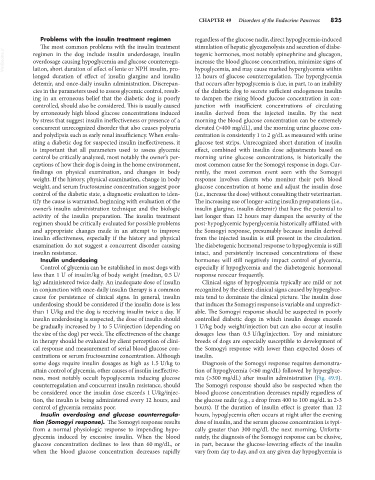Page 853 - Small Animal Internal Medicine, 6th Edition
P. 853
CHAPTER 49 Disorders of the Endocrine Pancreas 825
Problems with the insulin treatment regimen regardless of the glucose nadir, direct hypoglycemia-induced
The most common problems with the insulin treatment stimulation of hepatic glycogenolysis and secretion of diabe-
VetBooks.ir regimen in the dog include insulin underdosage, insulin togenic hormones, most notably epinephrine and glucagon,
increase the blood glucose concentration, minimize signs of
overdosage causing hypoglycemia and glucose counterregu-
lation, short duration of effect of lente or NPH insulin, pro-
12 hours of glucose counterregulation. The hyperglycemia
longed duration of effect of insulin glargine and insulin hypoglycemia, and may cause marked hyperglycemia within
detemir, and once-daily insulin administration. Discrepan- that occurs after hypoglycemia is due, in part, to an inability
cies in the parameters used to assess glycemic control, result- of the diabetic dog to secrete sufficient endogenous insulin
ing in an erroneous belief that the diabetic dog is poorly to dampen the rising blood glucose concentration in con-
controlled, should also be considered. This is usually caused junction with insufficient concentrations of circulating
by erroneously high blood glucose concentrations induced insulin derived from the injected insulin. By the next
by stress that suggest insulin ineffectiveness or presence of a morning the blood glucose concentration can be extremely
concurrent unrecognized disorder that also causes polyuria elevated (>400 mg/dL), and the morning urine glucose con-
and polydipsia such as early renal insufficiency. When evalu- centration is consistently 1 to 2 g/dL as measured with urine
ating a diabetic dog for suspected insulin ineffectiveness, it glucose test strips. Unrecognized short duration of insulin
is important that all parameters used to assess glycemic effect, combined with insulin dose adjustments based on
control be critically analyzed, most notably the owner’s per- morning urine glucose concentrations, is historically the
ceptions of how their dog is doing in the home environment, most common cause for the Somogyi response in dogs. Cur-
findings on physical examination, and changes in body rently, the most common event seen with the Somogyi
weight. If the history, physical examination, change in body response involves clients who monitor their pet’s blood
weight, and serum fructosamine concentration suggest poor glucose concentration at home and adjust the insulin dose
control of the diabetic state, a diagnostic evaluation to iden- (i.e., increase the dose) without consulting their veterinarian.
tify the cause is warranted, beginning with evaluation of the The increasing use of longer-acting insulin preparations (i.e.,
owner’s insulin administration technique and the biologic insulin glargine, insulin detemir) that have the potential to
activity of the insulin preparation. The insulin treatment last longer than 12 hours may dampen the severity of the
regimen should be critically evaluated for possible problems post-hypoglycemic hyperglycemia historically affiliated with
and appropriate changes made in an attempt to improve the Somogyi response, presumably because insulin derived
insulin effectiveness, especially if the history and physical from the injected insulin is still present in the circulation.
examination do not suggest a concurrent disorder causing The diabetogenic hormonal response to hypoglycemia is still
insulin resistance. intact, and persistently increased concentrations of these
Insulin underdosing hormones will still negatively impact control of glycemia,
Control of glycemia can be established in most dogs with especially if hypoglycemia and the diabetogenic hormonal
less than 1 U of insulin/kg of body weight (median, 0.5 U/ response reoccur frequently.
kg) administered twice daily. An inadequate dose of insulin Clinical signs of hypoglycemia typically are mild or not
in conjunction with once-daily insulin therapy is a common recognized by the client; clinical signs caused by hyperglyce-
cause for persistence of clinical signs. In general, insulin mia tend to dominate the clinical picture. The insulin dose
underdosing should be considered if the insulin dose is less that induces the Somogyi response is variable and unpredict-
than 1 U/kg and the dog is receiving insulin twice a day. If able. The Somogyi response should be suspected in poorly
insulin underdosing is suspected, the dose of insulin should controlled diabetic dogs in which insulin dosage exceeds
be gradually increased by 1 to 5 U/injection (depending on 1 U/kg body weight/injection but can also occur at insulin
the size of the dog) per week. The effectiveness of the change dosages less than 0.5 U/kg/injection. Toy and miniature
in therapy should be evaluated by client perception of clini- breeds of dogs are especially susceptible to development of
cal response and measurement of serial blood glucose con- the Somogyi response with lower than expected doses of
centrations or serum fructosamine concentration. Although insulin.
some dogs require insulin dosages as high as 1.5 U/kg to Diagnosis of the Somogyi response requires demonstra-
attain control of glycemia, other causes of insulin ineffective- tion of hypoglycemia (<60 mg/dL) followed by hyperglyce-
ness, most notably occult hypoglycemia inducing glucose mia (>300 mg/dL) after insulin administration (Fig. 49.9).
counterregulation and concurrent insulin resistance, should The Somogyi response should also be suspected when the
be considered once the insulin dose exceeds 1 U/kg/injec- blood glucose concentration decreases rapidly regardless of
tion, the insulin is being administered every 12 hours, and the glucose nadir (e.g., a drop from 400 to 100 mg/dL in 2-3
control of glycemia remains poor. hours). If the duration of insulin effect is greater than 12
Insulin overdosing and glucose counterregula- hours, hypoglycemia often occurs at night after the evening
tion (Somogyi response). The Somogyi response results dose of insulin, and the serum glucose concentration is typi-
from a normal physiologic response to impending hypo- cally greater than 300 mg/dL the next morning. Unfortu-
glycemia induced by excessive insulin. When the blood nately, the diagnosis of the Somogyi response can be elusive,
glucose concentration declines to less than 60 mg/dL, or in part, because the glucose-lowering effects of the insulin
when the blood glucose concentration decreases rapidly vary from day to day, and on any given day hypoglycemia is

